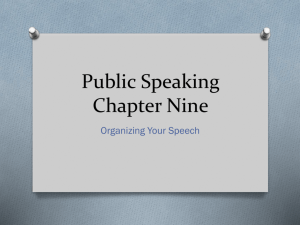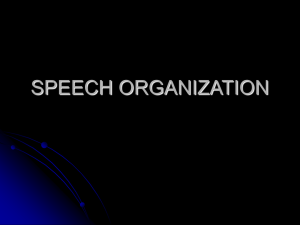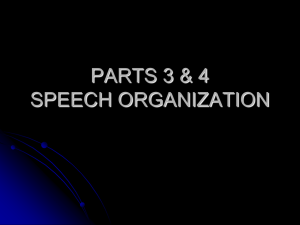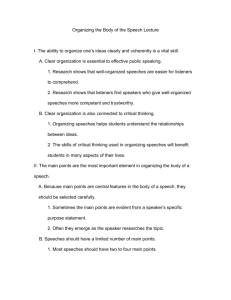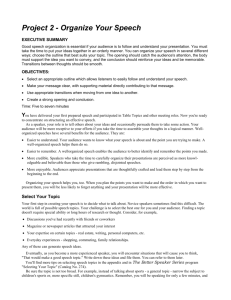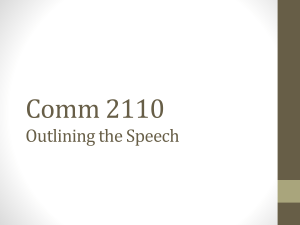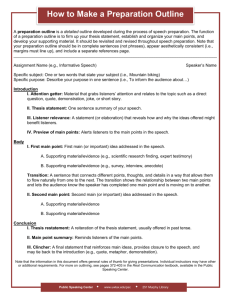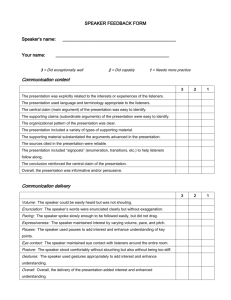Chapter Nine Lecture Notes
advertisement
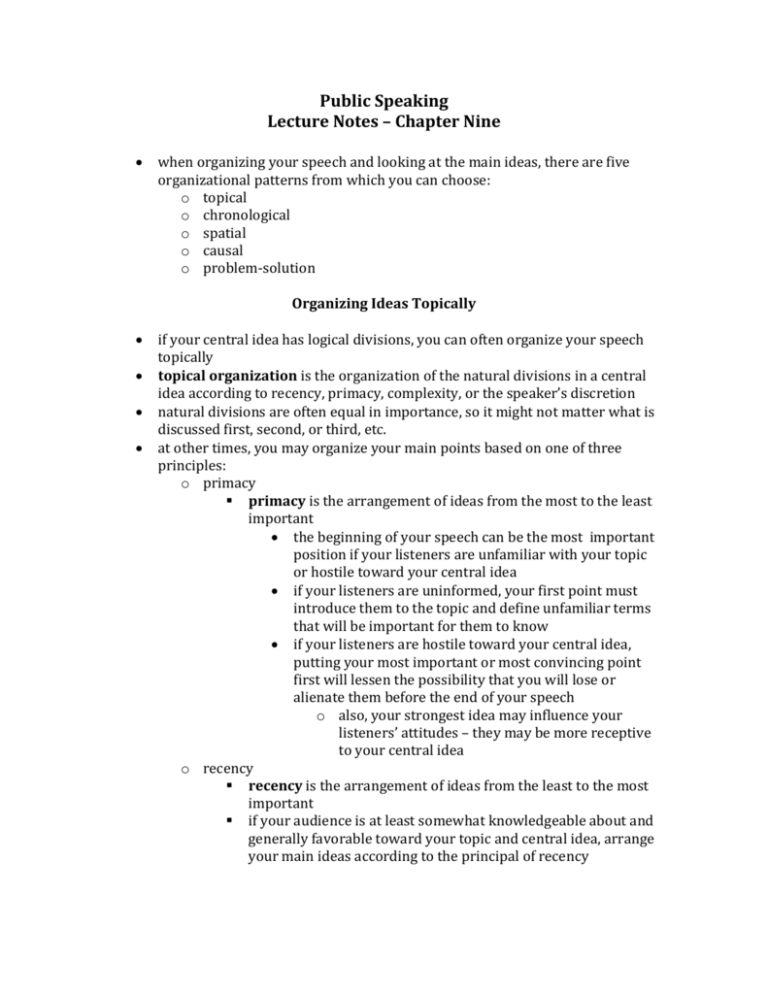
Public Speaking Lecture Notes – Chapter Nine when organizing your speech and looking at the main ideas, there are five organizational patterns from which you can choose: o topical o chronological o spatial o causal o problem-solution Organizing Ideas Topically if your central idea has logical divisions, you can often organize your speech topically topical organization is the organization of the natural divisions in a central idea according to recency, primacy, complexity, or the speaker’s discretion natural divisions are often equal in importance, so it might not matter what is discussed first, second, or third, etc. at other times, you may organize your main points based on one of three principles: o primacy primacy is the arrangement of ideas from the most to the least important the beginning of your speech can be the most important position if your listeners are unfamiliar with your topic or hostile toward your central idea if your listeners are uninformed, your first point must introduce them to the topic and define unfamiliar terms that will be important for them to know if your listeners are hostile toward your central idea, putting your most important or most convincing point first will lessen the possibility that you will lose or alienate them before the end of your speech o also, your strongest idea may influence your listeners’ attitudes – they may be more receptive to your central idea o recency recency is the arrangement of ideas from the least to the most important if your audience is at least somewhat knowledgeable about and generally favorable toward your topic and central idea, arrange your main ideas according to the principal of recency o complexity complexity is the arrangement of ideas from the simple to the more complex Organizing Ideas Chronologically chronological organization is organization by time or sequence o your steps are ordered according to when each step occurred or should occur historical speeches and how-to speeches are usually organized chronologically chronological organization involves either forward or backward progression, depending on which end a set of events the speaker intends to emphasize Organizing Ideas Spatially spatial organization is organization based on location or position it does not usually matter whether a speaker progresses up or down, east or west, forward or back – as long as he or she follows a logical progression speeches on subjects such as the Museum of Natural History or the travels of explorers – or even the structure of an atom can all be organized spatially Organizing Ideas to Show Cause and Effect cause-and-effect organization focuses on a situation and its causes or a situation and its effects speeches organized in this manner may first identify a situation and then discuss the effects that result from it (cause effect) or a speech could present a situation and then seek its causes (effect cause) Organizing Ideas by Problem and Solution if you want to emphasize how best to solve a problem, you will probably use a problem-and-solution method of organization problems and solutions can be discussed in either order o if you speak to an audience that already is aware of a problem, but not how to solve it, discuss the problem first and then the solutions o if your audience knows about an action or program that has been implemented, but does not know the reasons why, you should discuss the program or solution first, and then the causes for it Acknowledging Cultural Differences in Organization each culture teaches its members patterns of thought and organization that are considered appropriate for various occasions as an audience member, recognizing the existence of cultural differences when you are listening to a speech can help you appreciate and understand the organization of a speaker from a culture other than your own Subdividing Your Main Ideas after you have decided how to organize your main ideas, you may need to subdivide at least some of them o keep in mind that until you’ve delivered your speech, none are your decisions are final you may add, regroup, or eliminate main ideas or subpoints at any stage in the preparation process, as you consider the needs, interests, and expectations of your audience Integrating Your Supporting Material once you have organized your main ideas and subpoints, you are ready to add supporting materials to your speech Organizing Your Supporting Material sometimes, you can use the five standard organizational patterns to arrange your supporting material, as well as your main ideas and subpoints at other times, none of the five patterns will work and you will have to use a strategy that is more specifically adapted to your supporting materials o primacy or recency the organizational method can also be applied to supporting material o specificity sometimes, supporting material will range from very specific examples to more general overviews of a situation you can either offer your specific information first and end with a general statement or make the general statement first and support with specific evidence o complexity in many situations, it makes sense to start with the simplest ideas that are easy to understand and work up to more complex ones From Soft To Hard Evidence soft evidence is supporting material based mainly on opinion or inference; includes hypothetical illustrations, descriptions, explanations, definitions, and analogies hard evidence is factual examples and statistics o it is more accurate to think of soft and hard evidence as two ends of a continuum – with various supporting material falling somewhere in the middle Developing Signposts signposts are verbal or nonverbal signals that a speaker is moving from one idea to the next Transitions transitions indicate that a speaker has finished discussing one idea and is moving to another o verbal transitions in addition not only in other words in summary therefore finally, in conclusion – can be difficult to use because they can signal to a listener that it is time to stop listening / paying attention o better strategies include repeating a key word, use a synonym that refers to a previous idea, offering a final summary, or referring to the introduction of the speech o nonverbal transitions can occur in several ways, sometimes in conjunction with verbal transitions a change in facial expression a pause an altered vocal pitch or speaking rate movement good speakers use a combination of verbal and nonverbal transitions to move from one point to another throughout their speeches Previews audience-centered speakers need to remember that their audience members cannot go back to review a missed point a preview is a statement of what is to come internal preview – a statement in the body of a speech that introduces and outlines ideas that will be developed as the speech progresses Summaries summaries provide additional exposure to a speaker’s ideas and can help ensure that audience members remember them a final summary occurs just before the end of a speech, often acting as a transition between the body and the conclusion internal summaries are restatements in the body of a speech of ideas that have been developed so far Supplementing Signposts with Presentation Aids one way to increase the likelihood of listeners paying attention to your signposts is to supplement them with presentation aids o for example, bulleted or numbered outlines
